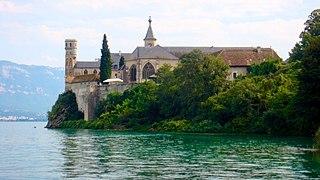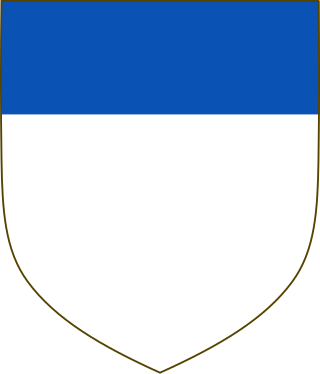
Humbert I, better known as Humbert the White-Handed or Humbert Whitehand, was the founder of the House of Savoy. Of obscure origins, his service to the Holy Roman Emperors Henry II and Conrad II was rewarded with the counties of Maurienne and Aosta and lands in Valais, all at the expense of local bishops and archbishops; the territory came to be known as the county of Savoy.
Otto was count of Savoy from around 1051 until his death. Through marriage to Adelaide, the heiress of Ulric Manfred II, he also administered the march of Susa from around 1046 until his death.

Peter I was count of Savoy and margrave of Turin jointly with his brother Amadeus II of Savoy from c. 1060 to 1078. He ruled only nominally, as true power was in the hands of his mother, Adelaide of Susa.
Amadeus II was the count of Savoy from 1078 to 1080. His life is obscure and few documents mention him. During his rule, he was overshadowed by his mother, but he had good relations with the papacy and, for a time, the Holy Roman emperor.
Humbert III, surnamed the Blessed, was Count of Savoy from 1148 to 1189. His parents were Amadeus III of Savoy and Mahaut of Albon. He ceded rights and benefits to monasteries and played a decisive role in the organisation of Hautecombe Abbey. It is said that he would rather have been a monk than a sovereign. On the death of his third wife, he retired to Hautecombe, but then changed his mind and, by his fourth wife finally had a son, Thomas. He sided with the Guelph party of Pope Alexander III against the Ghibelline emperor Frederick Barbarossa. The result was an invasion of his states twice: in 1174 Susa was set on fire, and in 1187 Henry VI banished him from the Holy Roman Empire and wrested away most of his domains. He was left with only the valleys of Susa and Aosta. He died at Chambéry in 1189. He was the first prince buried at Hautecombe. His memorial day is 4 March.
Herman IV was the Duke of Swabia (1030–1038). He was the second son of Ernest I and Gisela of Swabia. He was one of the Babenberg dukes of Swabia.

Hautecombe Abbey is a former Cistercian monastery, later a Benedictine monastery, in Saint-Pierre-de-Curtille in Savoie, France. For centuries it was the burial place of the members of the House of Savoy. It is visited by 150,000 tourists annually.

Boniface del Vasto was the margrave of Savona and Western Liguria from 1084 to c.1130. He was the son and successor of Otto and of Bertha, daughter of Ulric Manfred II of Turin. Boniface was a member of the Aleramici dynasty.

The Archdiocese of Turin is a Latin Church ecclesiastical territory of the Catholic Church in Italy.
Ulric Manfred II or Manfred Ulric was the count of Turin and marquis of Susa in the early 11th century. He was the last male margrave from the Arduinid dynasty. Ulric Manfred's daughter, Adelaide, inherited the majority of his property. Through marriage to Adelaide, Otto of Savoy, a younger son of Count Humbert I of Savoy became margrave of Turin. Their descendants would later comprise the House of Savoy who ruled Sardinia and Italy.

The March or Marquisate of Turin was a territory of medieval Italy from the mid-10th century, when it was established as the Arduinic March. It comprised several counties in Piedmont, including the counties of Turin, Auriate, Albenga and, probably, Ventimiglia. The confines of the march thus stretched across the Po Valley from the Western Alps in the north, to the Ligurian Sea.
Manfred I or Maginfred was the second Arduinici marquis of Susa from 977 until his death. Manfred was the eldest son of Arduin Glaber, from whom he inherited the county of Auriate and the vast March of Susa. The march extended from the Susa Valley by the Alps south across the Po to the Ligurian Sea. Although he ruled for almost twenty-five years, there is little evidence of his activities in surviving sources. Under him, Pavia became a mercantile city. He also controlled the road between Genoa and Marseilles.

Adelaide of Turin was the countess of part of the March of Ivrea and the marchioness of Turin in Northwestern Italy from 1034 to her death. She was the last of the Arduinici. She is sometimes compared to her second cousin and close contemporary, Matilda of Tuscany.

Hyacinthe Sigismond Gerdil, CRSP was an Italian theologian, bishop and cardinal, who was a significant figure in the response of the papacy to the assault on the Catholic Church by the upheavals caused by the French Revolution.
Frederick of Montbéliard or Frederick of Mömpelgard was from a noble family in Lotharingia. Through marriage, he became margrave of Turin (1080–1091).
Bertha of Milan or Bertha of Luni, was a countess margravine of Turin by marriage to Ulric Manfred II of Turin, and regent in Turin and Susa for her daughter Adelaide of Susa in 1033.
Immilla was a duchess consort of Swabia by marriage to Otto III, Duke of Swabia, and a margravine of Meissen by marriage to Ekbert I of Meissen. She was regent of Meissen during the minority of her son, Ekbert II.
Landulf of Turin was an Italian bishop. He was bishop of Turin from 1011 until his death in 1037.
Vitelmo of Turin or William of Turin was an Italian bishop. He was bishop of Turin from c. 1082 until his death in 1092.
John X, known as Giovanni da Besate or Giovanni Vincenzo, was the archbishop of Ravenna from 983 until 998.







